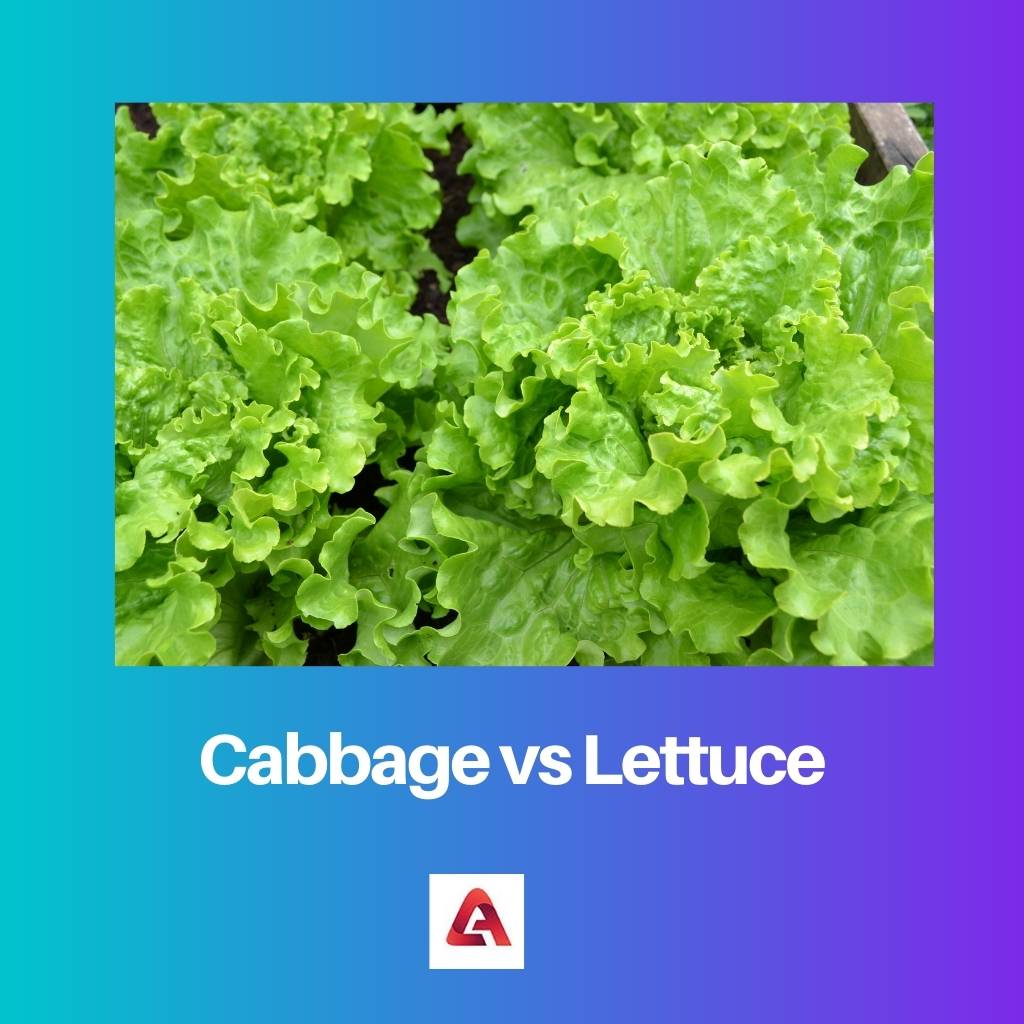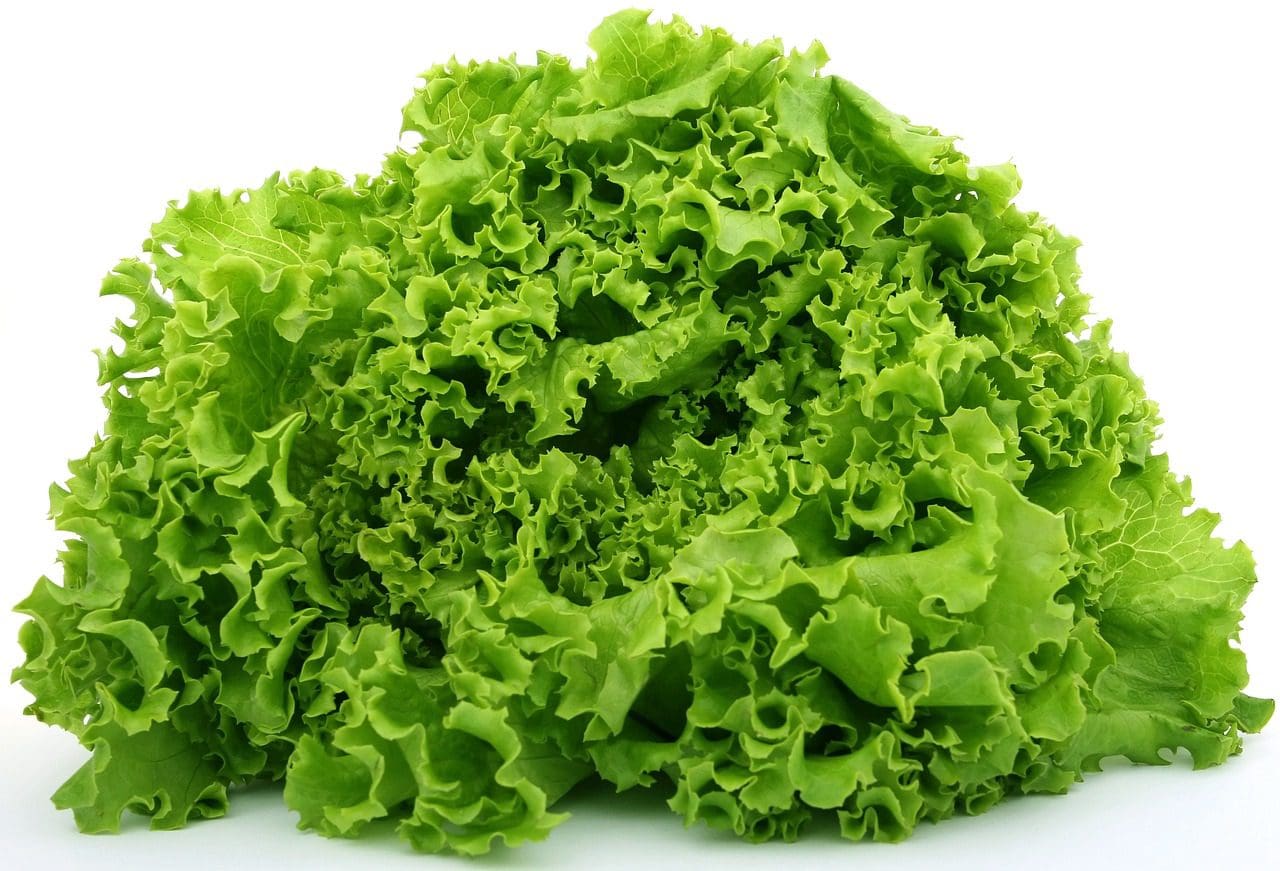Cabbage and lettuce are both leafy vegetables consisting of several vitamins and minerals. These vegetables are confused with being the same as they look quite similar to one another.
We have seen cabbage and lettuce being used in different types of food and cuisines. They both are considered to be healthy and have several health benefits.
Key Takeaways
- Cabbage has a denser, crunchier texture than lettuce’s more delicate, tender texture.
- Cabbage is cooked in various dishes, whereas lettuce is primarily consumed raw in salads or as a garnish.
- Cabbage is high in vitamin C and K, whereas lettuce is a good vitamin A and folate source.
Cabbage vs Lettuce
Cabbage is a round, short-stemmed, leafy green, red, or white biennial. Its rigid outer leaves are tightly wrapped around each other. Lettuce is an oblong-shaped annual plant of the family Asteraceae. Its outer leaves are soft and easy to remove from the stem, and it contains higher amounts of chlorophyll.

Cabbage is a leafy plant that is green, red, or white in color. The head or the bud is an edible part of the cabbage plant. It is descended from the wild cabbage and belongs to the brassicas plant family.
Cabbage is closely related to cauliflower and broccoli as all these plants are part of the wild cabbage family.
Lettuce is a plant with edible green leaves. Lettuce is a very common ingredient in salads, wraps, burgers, soups, etc. Fresh lettuce leaves are crunchy and moist. Many health-conscious people add lettuce to their meals as it is low on calories and is quite filling.
Comparison Table
| Parameters of Comparison | Cabbage | Lettuce |
|---|---|---|
| Origins | It is the origin of the Brassica oleracea plant family. | It is the origin of the Asteraceae plant family. |
| Calories | It has 25 calories per 100 grams. | It has 14 calories per 100 grams. |
| Vitamins | It is rich in vitamin C and vitamin K. | It is high in beta corotena which later for,s vitamin A. |
| Nutritive Content | It is high in nutritive content compared to lettuce. | It is less in nutritive content compared to cabbage. |
| Fiber | It is high in fiber compared to lettuce. | It is less in fiber compared to cabbage. |
What is Cabbage?
Cabbage is a plant popular for its edible leafy head. It has chewy, rubbery thick leaves. Its organic components make it a little bitter and peppery when eaten raw. However, it easily gets combined with spices and gets neutralized when it is cooked, losing its bitter taste.
There are almost four hundred types of cabbages among them. Four are common ones. They are green cabbage, red or purple cabbage, savoy cabbage, napa cabbage.
The green cabbage is a very common type of cabbage that we all are very familiar with. Green cabbage is fried or sautéed to make various types of dishes.
Purple or red cabbage is very popularly used to bring color to food. They are also steamed and used to make dumplings. Cabbage consists of many important vitamins, such as vitamin K, vitamin C, and vitamin A. It also is loathed with several minerals like calcium, potassium, manganese, etc.
The high amount of vitamin C in cabbage helps the body in various ways. Cabbage is also helpful in improving digestion as it is high in fibre. Overall, cabbage is as good as other leafy vegetables but should be consumed in a balanced manner.

What is Lettuce?
Lettuce has now become one of the world’s popular vegetables as it adds a crunch to salads and acts as a good base for wraps. It is also available in dark green, red and purplish colors.
It is a leafy vegetable with a good crunchy, and watery taste. It is a little thinner and less chewy compared to cabbage.
It is a rich source of vitamin A, and vitamin K. Lettuce is low in fibre and calories compared to cabbage. There are mainly two types of lettuce butterhead lettuce and crisphead lettuce.
As the name suggests, butterhead lettuce is soft and smooth textured, whereas crisphead ones are hard and crunchy.
Lettuce grows in warm weather and requires an abundant amount of water to grow. It is native to southern Europe and western Asia. Lettuce wraps are very popular dishes in Laos and Thailand. However, they were originally introduced in China.
Romaine and iceberg lettuce are very famous in the US. They are used in Caesar salad and are considered the best types around the world.

Main Differences Between Lettuce and Cabbage
- Lettuce and cabbage are originated from different plant species. Both of their leaves may look very similar. They can be easily differentiated by their texture and tastes.
- Lettuce is moister, crunchier, and easily chewable compared to cabbage. Lettuce is more textured when compared to cabbages.
- Cabbage is fried and sautéed along with spices and other vegetables so as to make them softer and tastier, whereas lettuce is mostly used in wraps and burgers.
- Lettuce contains fewer calories than cabbage. But cabbage is richer in vitamins, minerals, and fibre compared to lettuce.
- Cabbage is grown in cooler weather with irrigation throughout the growing period. Lettuce is grown in warm weather and requires a lot of watering.

Refrences
- https://www.sciencedirect.com/science/article/pii/S0308814604000366
- https://meridian.allenpress.com/jfp/article-abstract/53/10/831/165437
- https://link.springer.com/chapter/10.1007/978-0-387-30443-4_3

The nutritional benefits of cabbage and lettuce are highlighted in great detail. This article serves as an enlightening resource for those interested in dietary health.
Absolutely, Roxanne18. Understanding the nutritional aspects of these vegetables can guide individuals towards healthier dietary choices.
Thanks for this insightful article on the differences between cabbage and lettuce. It’s important to understand their nutritional content and uses in cooking.
Absolutely, Eden60. Cabbage and lettuce are thought of interchangeably, but they’re quite different in their uses and health benefits.
It’s fascinating to learn about the origins and vitamin contents of cabbage and lettuce. This information is very beneficial for making informed dietary choices.
Absolutely, Campbell John. Being aware of the nutrients in these vegetables can help individuals tailor their meals according to their dietary needs.
The comparison table helped me understand the distinctive nutritional values of cabbage and lettuce. Both are equally important in a balanced diet.
I agree, Eva Thomas. It’s crucial to incorporate a variety of vegetables like cabbage and lettuce for a well-rounded diet.
The information presented here makes a compelling case for including both cabbage and lettuce in a balanced diet. The distinctive characteristics of each vegetable are quite intriguing.
I couldn’t agree more, Edward Davis. Understanding the unique qualities of cabbage and lettuce is crucial for dietary diversity.
The details about the different types of cabbages are intriguing. It’s great to know the various ways in which these veggies are used in cooking.
Absolutely, Florence. Learning about the culinary diversity of cabbages is both fascinating and enriching.
I completely agree, Florence Walker. The different types of cabbages lend themselves to a wide range of culinary applications.
The detailed information about the origins and nutrient content of cabbage and lettuce is enlightening. I appreciate the in-depth analysis provided here.
Absolutely, Chloe61. This article is a valuable educational resource for understanding the importance of cabbage and lettuce in nutrition.
I completely agree, Chloe61. The thorough examination of these vegetables sheds light on the value they bring to our diets.
This article provided a comprehensive overview of the characteristics of cabbage and lettuce. Understanding the finer details is essential in appreciating the diversity of vegetables.
I couldn’t agree more. The distinct qualities of cabbage and lettuce are truly remarkable.
Well said, Lewis Jason. It’s important to acknowledge and celebrate the unique qualities of various vegetables.
The comparison of the fiber content and nutritive value of cabbage and lettuce is particularly enlightening. These aspects play a vital role in dietary health.
Well articulated, Zwilson. Understanding the nutritional profiles of various vegetables is essential for making informed dietary decisions.
Precisely, Zwilson. The nutritional comparison provides valuable insights into the health benefits of cabbage and lettuce.
The detailed description of the differences between cabbage and lettuce is enlightening. It’s essential to recognize and appreciate the diversity of vegetables in our diets.
Well stated, Jackson Daniel. This article provides valuable insights into the unique characteristics of cabbage and lettuce.
Absolutely, Jackson Daniel. Embracing the diversity of vegetables like cabbage and lettuce enriches our culinary experiences.